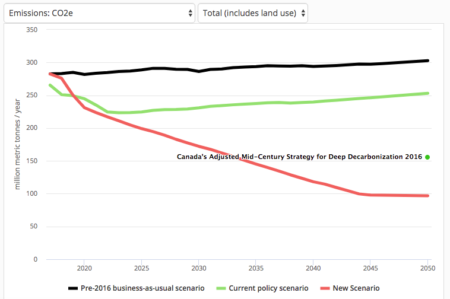The Pembina Institute has released a new interactive tool that lets anybody test out alternative approaches to setting energy policy for Alberta, in sectors including transport, buildings, electricity generation, and agriculture.
It doesn’t allow a huge amount of ambition. For instance, the only bitumen sands policy option is the 100 megatonne cap which the Alberta government has proposed, which you can tweak to be implemented more clearly. Still, it does a nice job of illustrating the relative impact of different approaches, from a faster phase-out of coal in electricity generation to various policies targeting vehicles, methane emissions, cement production, and sector-specific carbon taxes up to $350 per tonne.
Even with the most aggressive coal phase-out options, the bitumen sands cap, and $350 carbon taxes in all sectors, projected emissions only fall from a current level around 275 megatonnes of CO2-equivalent to around 100 megatonnes in 2045:
Even if every jurisdiction in the world achieved cuts at that rate, it wouldn’t be fast enough to produce a sub-2 ˚C warming scenario as called for in the Paris Agreement, and any politically plausible global pathway would see countries with very high per capita and historical emissions like Canada cut deeper and faster than the average.
I have previously posted about climate change games/simulations from the BBC and Chevron.


Is policy ever even this coordinated and directed? Or is it more the random results of elections and the talking points of the people who run in them?